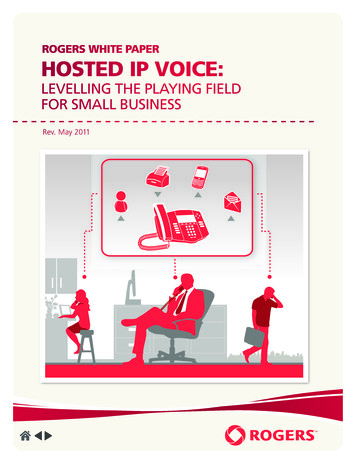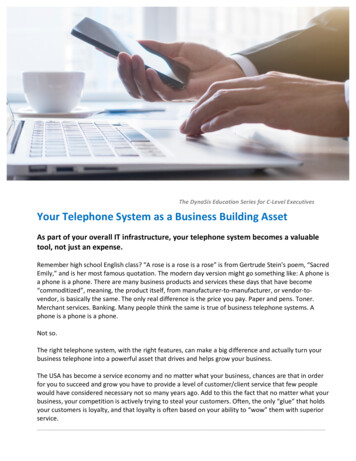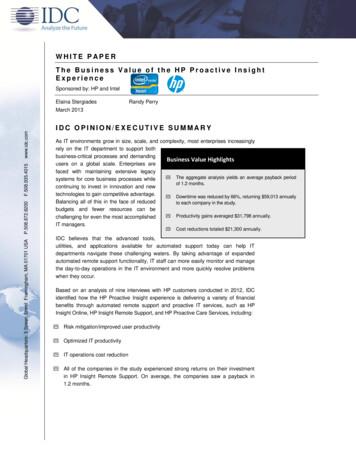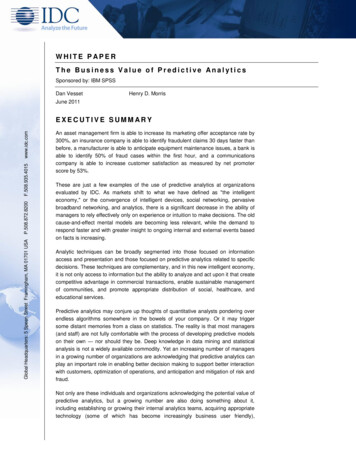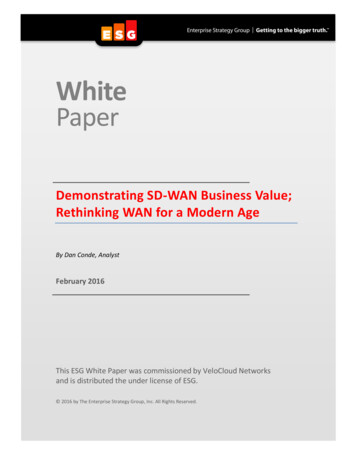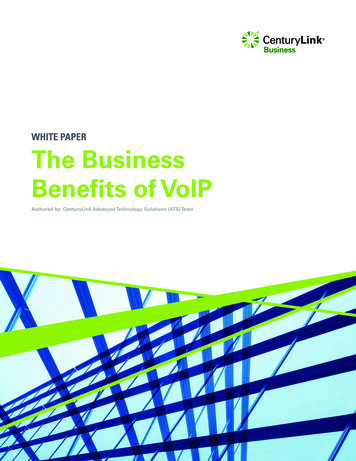
Transcription
WHITE PAPERThe BusinessBenefits of VoIPAuthored by: CenturyLink Advanced Technology Solutions (ATS) Team1White PaperT he Business Benefits of VoIP
WHITE PAPERThe Business Benefits of VoIPMore than ever, enterprises are relying on technology to help solveAs with any IT project, budget is a consideration factor. Youtheir business issues while constantly seeking better technologicialhave to decide between continuing to spend capital andinnovations that improve both operational efficiencies and betterresources to maintain your current voice TDM architecture ormanage expenses. Nowhere is this more evident than withconsidering another course. With challenge comes opportunity.voice communications where companies, through growth andTDM’s impending sunset presents an opportunity to organize,acquisition, are maintaining and managing disparate phone systemsunify and standardize your network, as these forward-thinkingand multiple legacy voice networks. Additional concerns — suchenhancements will prepare your company for the future. Thisas equipment vendors phasing out support for some TDM (timewhite paper analyzes why a move from TDM to a Voice over IPdivision multiplexing) components and the need to support an(VoIP) is a beneficial solution for your enterprise.increasingly mobile and virtual workforce require companies toconsider new voice service options.VoIP is a Priority for Today's Enterprises 1Level of Priority of Data/Voice Network Management,Unification, and Innovation in Supporting BusinessGoals — Next 12 MonthsIt is important to understand the differences between TDM andVoIP call processing. For each TDM phone call, an analog call is transportedover copper wires from the caller to the called party. EachTDM call is a dedicated physical connection end to end andCritical PriorityVery Important1%16%33%requires a business line purchased from a carrier. 16%VoIP encapsulates the analog voice audio into digital datapackets. All voice, video, and data packets are simultaneouslyModerate Priorityprocessed on the local area network (LAN) or over theLow Priorityexternal wide area network (WAN) when required.36%As you are thinking about the move to VoIP, assess your currentdata network to learn how voice calls will affect its ability toVoice over internet protocol (VoIP) puts voice call traffic onthe enterprise’s existing Intranet — or IP-based network.It allows a person to make voice calls by converting soundto data and processing it across a data network rather thanusing conventional or analog phone systems with TDM lines.In today’s market, data bandwidth is less expensive thanever, so expanding its capability to handle voice is an optimaltransformation. Moving to VoIP enables you to use one networkfor both data and voice — removing the need to rely on thecostly and aging TDM technologies.2White PaperT he Business Benefits of VoIPfunction for simultaneous voice and data traffic. A correctly sizednetwork is critical for a successful transition. In addition to theLAN, will the WAN also be capable of handling VoIP call traffic?Both questions are valid and should be addressed.
There are a number of ways to provide adequate call quality.can use call admission control (CAC) mechanisms and VLANsQuality-of-Service (QoS) network capabilities help manage theto protect voice traffic from competing network traffic andLAN and WAN so call quality does not suffer in the convergedprevent excessive voice traffic from flooding the WAN network.environment. The LAN and WAN class of service and qualityCAC rejects calls when there is insufficient CPU processingof service (CoS/QoS) can provide for voice prioritization overpower, when the upstream and downstream traffic exceedsother traffic. On the LAN, separate virtual LANs (VLANs) can bepre-specified thresholds, or when the number of calls handledcreated for data and voice in the local network. Data and voiceexceeds a specified limit. Combined, these tools have made VoIPtraffic can compete with one another on the network, which mayeasier to manage without a negative effect on voice quality.cause uneven voice audio quality. To mitigate this problem, youBenefits of VoIPThere are many benefits of moving to VoIP, some of which are not even offered as an option with TDM. The cost to maintain andmanage TDM infrastructure is reflected at both the customer level and the carrier level. Operating costs of VoIP service providersare lower than traditional TDM phone companies, which must contend with expensive-to-maintain telephony architecture and costlyregulations. Lower costs allow the VoIP provider to charge less while providing more features.Many features and services are built into the VoIP platform or included by the provider-saving businesses from spending on the samefunctionality at the enterprise level. With TDM, you pay monthly for many of the features you need, such as caller ID, call forwarding,three-way calling and more. In contrast, VoIP providers include these features in the monthly cost of the service. These can beimplemented user by user or location by location.Increasing ProductivityVoIP services make your voice communication capabilities more flexible. They enable cost savings and productivity features that TDMhas trouble matching: Always available: Today, many VoIP offerings are configured eliminates the need for employees to master multiple phonecell — making it easy for customers and partners to reachsystems as they move around the organization. Employeesyour employees thereby reducing “phone tag” situations.can be responsive and productive on day one, with lessAchieving this “always available” feature with a TDMsystem would require additional lines to forward the call training required. Portability: Once an employee has a phone number, thatto a secondary device and possibly additional PBX (privatenumber can follow him or her throughout the enterprise. Ifbranch exchange) equipment.an employee moves to another physical location either withinEnable a virtual workforce: As long as users have accessthe building or to another location, he or she can take theirto a broadband connection, they can continue to handlephone, plug it into a LAN port and along with the number, allcalls outside of the physical walls of the office — even whilefeatures and capabilities will follow. This saves IT staff timetraveling — via software installed on PCs and mobile devicesas there is no need to physically move equipment —that enable users to make and receive calls. External callersadministration is managed via a provider web-based portal.can reach employees using their published company phoneTechnicians are no longer required to move users to anumber while keeping the employee’s mobile number private.new cube or physical location as this can now be easilyVoicemail via email: With VoIP, voicemail can automaticallyaccomplished via an online portal.be forwarded to the user’s regular email box as a wavfile attachment or transcribed and sent as text. With allmessages in one archive, employees can read or listen totheir messages and forward them if necessary.3Combine and simplify features: VoIP standardizationto simultaneously ring on multiple devices — such as yourWhite PaperT he Business Benefits of VoIP
Business EfficienciesVoIP can assist enterprises by increasing efficiencies in IT operations: Virtual numbers anywhere: Many enterprises are Easier migration and deployment: VoIP can be deployedexpanding their services into markets where they do notwith little cost because it operates on your existing LAN andhave a physical presence. With VoIP, you can have a localWAN. Performing network assessments can identify whatphone number in an area code you select. You don’t need ais needed to introduce VoIP into your ecosystem. Migrationphysical system in that location. The VoIP line can connectto VoIP is easy to deploy. It is a matter of setting up thecalls to a location in a different region of the country.service with a VoIP provider and migrating to the convergedBecause of TDMs rigidity and regulations, a local phoneLAN and WAN architecture. VoIP can coexist with a TDMnumber in that market must be purchased requiring a formenvironment, with the migration coordinated over time. Noof call forwarding redirecting the call to another device ormore “flash cuts” into a new architecture.location. In these cases, there is a cost monthly in eachmarket and often a cost per minute for each call processed.Reducing Costs Ongoing monthly savings: Today your TDM bills are basedPBXs and other voice hardware requires an enterprise tohave one or more technical resources available to performIf you are in an area of the country where minute-of-useactivities on the equipment. For some of these systems,charges exist for local calls, this cost does not apply whenthe available resources are limited as the equipment mayusing VoIP. It is important to note that standard long distanceno longer be supported by the manufacturer, and thereforerates on VoIP are often less expensive than traditional TDM.you may pay a premium for maintenance and techniciansBetter bandwidth utilization: Did you realize that duringto support your environment. As stated earlier, the phone isa voice conversation there is an average of 35-50% ofanother data device and managed using the data technicalsilence during each call? When moving to VoIP this utilizationresources. You are no longer required to hire, train andsavings can be applied so more calls can use the samemanage legacy TDM IT staff. With VoIP, this can free upamount of bandwidth. During those periods of silence, thethose IT resources to focus on strategic efforts aligned withbandwidth is available on the network for other voice, datathe core business objectives.Moves, adds, changes and deletions (macd) activitiesvia portal: Most VoIP providers offer online access forperforming user-level changes as well as administrationactivities such as, moves, adds, changes, and deletionsand modifying the features available for the enterprise. Nomore dispatching technicians or paying for MACD changesin the environment.4Technical resource cost management: Today, most TDMcompanies on the same network with no additional charges.or video communications. on regulated fees and services. With VoIP, you can call otherWhite PaperT he Business Benefits of VoIP
Simplifying Management Converged network architecture: Today, many companies to process all communications enables an enterprise tomanaged by separate resources. With VoIP, the telephonequickly augment the capacity on its network. Companiesbecomes another data device in the data infrastructure;can dynamically re-allocate existing bandwidth from data totherefore, there is now one network to manage. Most ofvoice to accommodate increases in call volume, a processthe VoIP telephones available today have capabilities insidethe telephone, allowing the PC to be plugged into the back Rapid increase in capacity: Using your data networkhave separate voice and data networks. Generally, these arethat is not possible with traditional TDM voice circuits. Scalability: Since VoIP uses your data connectivity,of the phone thereby sharing a single LAN connection forexpanding and decreasing the data bandwidth based can beboth devices using VLANs (virtual LAN) to separate andaccomplished quickly with your carrier to accommodate voiceprioritize the traffic.traffic peaks and valleys throughout the course of the year.Business continuity: It is common for a data environmentThis means hours/days to add bandwidth rather than weeksto have some level of redundancy; this aspect of businessrequired in the TDM network. In addition, there will be nocontinuity may now be extended to the VoIP architecture.PBX expense required to accommodate this traffic growth —With several network level and site level options available,no technician expense to perform work on the PBX, noyou have the choice to create many levels of redundancy.equipment expenditures and no additional management orThis savings no longer requires a duplication of TDM circuitsmaintenance costs. Scale your network to fit your needs.and PBX equipment to create a failover voice strategy.Improving Productivity Improved support for remote workers: Remote workerscommunication using VoIP as it is based on industry standardtoday connect to the data network using VPN or Internetwell established in the marketplace today. This allows theaccess. With the VoIP applications running on the datanetwork, this now expands the ability to use this access for Video support: Video is not easily supported on most localvoice communications as well.TDM networks without purchasing a circuit designed forData application integration: There is high businessthat purpose. With VoIP, point-to-point video is allowed —demand for more collaboration and telephony integrationprovided the users have a supported application, a PC withwith data tools. Network application developers will find itvideo capabilities or a video-capable device at each end.easier to develop and deploy emerging applications for data5enterprise to expand and use new applications faster. White PaperT he Business Benefits of VoIP
VoIP Implementation ChoicesThere are multiple ways of deploying VoIP in an enterprise, including a hybrid approach, to the multitude of VoIP choices. Althougheach option has various features and function that differentiate one from the other, the lowest common denominator is where the VoIParchitecture should reside. The following identifies the most elemental differences when considering a cloud-based VoIP solution. Hosted VoIP: Hosted VoIP services are delivered via thecloud. Because of this, it is the easiest of all VoIP optionsto deploy, with very little maintenance cost and the lowestcapital expense (CapEx). Hosted VoIP is per-seat priced,including the phone, with all of the responsibility of theapplications servers and the robust features and capabilitiesand maintenance falling on the provider.Situations that may benefit from this type of offering:–– Reducing CapEx–– Reliable and good bandwidth at all locations–– Limited IT staff–– Staff travels often or telecommutes–– Limited third-party integration–– Small offices (100 or fewer users per site) Premise or data center hosted VoIP architecture: Theseinclude providing a system that is owned and managed bythe service provider. This VoIP system can be located at anon-premises location or in a data center. This option wouldhave a dedicated platform for the enterprise with WANconnectivity and using SIP Trunking capabilities.Situations that may benefit from this type of offering:–– Reduced OpEx pending–– Complex voice environment–– Many users (100 users per location)–– Heavy third-party integration–– No seasonal staffing–– Have dedicated IT Staff–– Strongly regulated HIPAA, PCI Compliance, encryptionor other regulatory requirements6White PaperT he Business Benefits of VoIP
ConclusionVoice communications are an essential part of every workinvestments to strategic projects can be a boon to differentiatingenvironment and will continue to be one of the most widelythe business from competitors. As this paper explains, any VoIPused enterprise applications for the foreseeable future. Migratingarchitecture chosen will provide more benefits than you evenfrom TDM to VoIP can be a gradual evolution because it doesimagined from your voice communications.not involve actually deploying a new network. It is aboutexpanding and executing a converged telecommunication dataCenturyLink delivers a full range of VoIP services, from hosted VoIPstrategy that will carry the business well into the future. Theto IQ-SIP Trunk to managing your existing VoIP infrastructure. Callright ecosystem can lay the foundation for growth, managementus at 1-855-262-3445 or contact us via the web. Discover how aand scalability and help improve the bottom line by providingCenturyLink VoIP solution can improve the operational efficiency offlexibility, increased efficiency and reduced costs. The increaseyour business while reducing cost and complexity.in employee productivity and reallocation of technologyAbout CenturyLink BusinessAbout the CenturyLink ATS TeamCenturyLink, Inc. is the third largest telecommunicationsThe CenturyLink Advanced Technology Solutions organization is acompany in the United States. Headquartered in Monroe, LA,team of highly experienced customer facing sales and engineeringCenturyLink is an S&P 500 company and is included among theindividuals providing technical and strategic customer solutions onFortune 500 list of America’s largest corporations. CenturyLinkCenturyLink VoIP, network and hosting solutions.Business delivers innovative private and public networking andmanaged services for global businesses on virtual, dedicatedand colocation platforms. It is a global leader in data and voicenetworks, cloud infrastructure and hosted IT solutions forenterprise business customers.For more information visit www.centurylink.com/VoIPSolutions.1 IDG Market Pulse Research Survey, January 2016Global HeadquartersMonroe, LA(800) 784-2105EMEA HeadquartersUnited Kingdom 44 (0)118 322 6000Asia Pacific HeadquartersSingapore 65 6768 8098Canada HeadquartersToronto, ON1-877-387-3764 2016 CenturyLink. All Rights Reserved. The CenturyLink mark, pathways logo and certain CenturyLink product names are theproperty of CenturyLink. All other marks are the property of their respective owners. Services not available everywhere. Businesscustomers only. CenturyLink may change or cancel services or substitute similar services at its sole discretion without notice.791030816 - business-benefits-voip-whitepaper-WP160048
white paper analyzes why a move from TDM to a Voice over IP (VoIP) is a beneficial solution for your enterprise. VoIP is a Priority for Today's Enterprises 1 Level of Priority of Data/Voice Network Management, Unification, and Innovation in Supporting Business Goals — Next 12 Months Voice over internet protocol (VoIP) puts voice call traffic on
